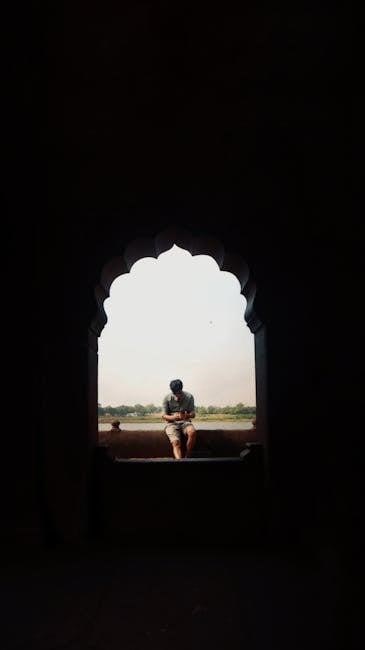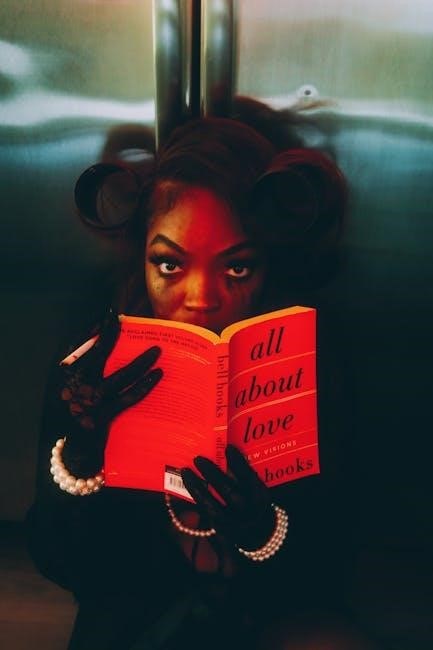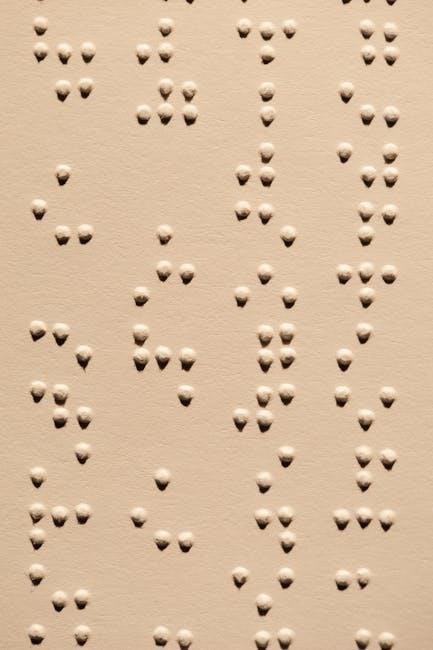Anthony Doerr’s All the Light We Cannot See is a mesmerizing WWII novel intertwining the journeys of Marie-Laure, a blind French girl, and Werner, a German orphan, exploring hope, survival, and interconnectedness amidst war’s chaos.
Overview of “All the Light We Cannot See”
All the Light We Cannot See, a Pulitzer Prize-winning novel by Anthony Doerr, is a captivating tale set during World War II. It follows the intersecting lives of Marie-Laure, a blind French girl, and Werner, a German orphan turned soldier. The story unfolds against the backdrop of Nazi-occupied France and Germany, exploring themes of hope, survival, and the human condition. The title reflects the light that connects the characters—both literal and metaphorical—amidst the chaos of war. Doerr’s lyrical prose and non-linear storytelling weave a powerful narrative of resilience and the enduring power of compassion.
Historical Context: World War II Setting
Set against the backdrop of World War II, All the Light We Cannot See vividly portrays the chaos and destruction of the era. The novel captures the invasion of Paris, the Nazi occupation of France, and the horrors of war-torn Europe. Key events, such as the bombing of Saint-Malo in August 1944, serve as pivotal moments in the story. The historical context underscores the struggles of characters like Marie-Laure, a blind French girl, and Werner, a German orphan turned soldier, as they navigate survival, loss, and moral dilemmas amidst the war’s brutality. The setting enriches the narrative with authenticity and emotional depth.

Key Characters and Their Journeys
Marie-Laure, a blind French girl, and Werner, a German orphan, navigate survival, hope, and moral conflicts in WWII, their paths intertwining in a tale of resilience.
Marie-Laure LeBlanc: The Blind French Girl
Marie-Laure, a young Parisian girl, loses her sight due to cataracts and learns to navigate the world through touch and imagination. Her father, a locksmith, creates intricate models of their neighborhood to aid her. When Paris falls to the Nazis, Marie-Laure and her father flee to Saint-Malo, where her great-uncle shelters them. Her journey is marked by resilience, as she adapts to blindness and discovers inner strength, symbolizing hope amidst war’s devastation. Her connection to the mysterious Sea of Flames diamond adds depth to her story.

Werner Pfennig: The German Orphan Turned Soldier
Werner, a curious and scientifically gifted German orphan, grows up in a mining town with his sister Jutta. Recruited by the Nazis for his technical skills, he becomes embroiled in the war, tracking down illegal radio broadcasts. Torn between duty and morality, Werner’s journey reflects the complexities of individual choice amidst national ideology. His path intersects with Marie-Laure’s during the bombing of Saint-Malo, where he faces a pivotal moral decision. Werner’s story explores the tension between scientific pursuit and the ethical dilemmas of war, highlighting the human cost of conflict and the struggle to retain humanity in a fractured world.
Supporting Characters: Von Rumple, Etienne, and Daniel
Von Rumple, a ruthless Nazi sergeant, embodies the banality of evil, obsessed with seizing the legendary Sea of Flames diamond. Etienne, Marie-Laure’s great-uncle, provides refuge in Saint-Malo and aids the French Resistance through illegal broadcasts. Daniel, Marie-Laure’s father, creates intricate models of their surroundings to help her navigate blindness. Each character’s actions ripple through the story, influencing the protagonists’ paths and the novel’s themes of resistance, hope, and survival. Their roles underscore the resilience of humanity and the moral choices that define individuals amidst war’s devastation and uncertainty.

Themes and Symbolism
The novel explores themes of hope, survival, and moral choices, intertwined with symbolic elements like light, blindness, and the elusive Sea of Flames diamond, reflecting humanity’s struggle and resilience in wartime.
Hope and Survival in the Midst of War
Amidst the devastation of WWII, All the Light We Cannot See underscores the enduring power of hope and resilience. Marie-Laure, despite her blindness, finds solace in stories and her father’s guidance, while Werner grapples with the moral complexities of war. The novel highlights how individuals cling to small acts of kindness and courage, even as the world around them crumbles. Through their interconnected journeys, Doerr illustrates that hope is not the absence of darkness but the light that persists within it, offering a beacon for survival and humanity in the face of unimaginable despair.

The Role of Science and Technology
Science and technology play a pivotal role in All the Light We Cannot See, shaping the characters’ lives and the war’s trajectory. Werner’s fascination with radios and engineering underscores the dual nature of technology—as a tool for progress and a weapon for destruction. His ability to track illegal broadcasts highlights the intersection of science and surveillance, while the pursuit of the Sea of Flames diamond symbolizes the dangerous allure of technological and scientific ambition. The novel explores how these elements both unite and divide, reflecting the tension between human potential and the ethical dilemmas of innovation during wartime.
Moral Choices and the Banality of Evil
All the Light We Cannot See delves into the complexities of moral choices during WWII, illustrating how ordinary individuals grapple with extraordinary ethical dilemmas. Werner’s journey from innocence to complicity reveals the insidious nature of evil, where small, seemingly insignificant decisions contribute to larger atrocities. The novel highlights the banality of evil through characters like von Rumple, whose bureaucratic role in the war machine underscores how systemic oppression thrives on routine and indifference. Doerr’s portrayal challenges readers to reflect on the human capacity for both cruelty and compassion in the face of overwhelming moral ambiguity.
Plot Structure and Narrative Style
The novel employs a non-linear narrative, weaving together the interconnected lives of Marie-Laure and Werner through short, alternating chapters, creating suspense and emotional depth.
Non-Linear Storytelling and Interconnected Lives

The novel’s narrative unfolds in a non-linear fashion, alternating between the lives of Marie-Laure and Werner. Through concise, interconnected chapters, Doerr masterfully weaves their journeys, revealing how their paths converge during the bombing of Saint-Malo. This structure builds suspense and emotional depth, emphasizing the shared humanity of its characters despite their vastly different experiences. The story’s non-linear flow mirrors the chaos of war, yet it underscores the subtle, often invisible threads that bind lives together. This unique storytelling approach heightens the novel’s emotional impact and thematic resonance.
The Climax: The Bombing of Saint-Malo
The bombing of Saint-Malo in August 1944 marks the novel’s emotional and chaotic climax. Allied forces target the Nazi-occupied town, trapping Werner in a collapsing building and forcing Marie-Laure to confront the horrors of war. The destruction intensifies as Werner, desperate to survive, makes a moral choice by killing von Rumple. Meanwhile, Marie-Laure seeks refuge in the safety of her great-uncle’s house. This pivotal moment intertwines their lives, showcasing the devastation of war and the resilience of hope. The climax underscores the novel’s themes of survival and the human cost of conflict.
Symbolism and Metaphors
The novel richly employs symbols like the Sea of Flames diamond, representing both light and destruction, while radio waves and blindness symbolize connection and the unseen, highlighting hope amidst chaos.
The Sea of Flames Diamond: A Symbol of Light and Destruction
The Sea of Flames diamond is a central symbol in the novel, representing both creation and destruction. Its beauty and power captivate characters like Von Rumple, driving their obsessions. The diamond’s cursed history mirrors the devastation of war, while its brilliance symbolizes hope and resilience. Marie-Laure’s connection to it underscores her journey toward understanding light and darkness. The diamond’s dual nature reflects the novel’s themes of moral choices and the duality of human actions, making it a powerful metaphor for the destructive and redemptive forces at play during WWII.
All the Light We Cannot See leaves a lasting impact, offering a poignant reflection on hope, survival, and humanity. Its Pulitzer Prize win underscores its literary significance, while its adaptation and cultural influence continue to resonate, making it a timeless tale of war’s profound effects on individuals and society.
Impact of the Novel on Readers
Anthony Doerr’s All the Light We Cannot See profoundly impacts readers by weaving a emotional tapestry of hope and resilience during WWII. Winning the Pulitzer Prize, the novel is celebrated for its vivid storytelling. Readers experience the characters’ struggles, fostering empathy and reflection. The narrative transcends historical fiction, offering universal themes of survival and moral choices. The novel’s lyrical prose and intricate characters leave a lasting impression, resonating with readers long after finishing the book. Its ability to balance despair with hope makes it a timeless and deeply moving read.
Adaptations and Cultural Significance
All the Light We Cannot See has transcended literature, gaining cultural prominence through adaptations. A Netflix miniseries brought its story to screens, expanding its audience. The novel’s themes of hope and survival resonate universally, making it a modern classic. Its Pulitzer Prize win elevated its status, influencing contemporary historical fiction. Barack Obama’s endorsement further highlighted its cultural impact. The story’s timeless appeal continues to captivate readers and viewers alike, cementing its place in both literary and popular culture. Its adaptation underscores the enduring power of its narrative.




About the author